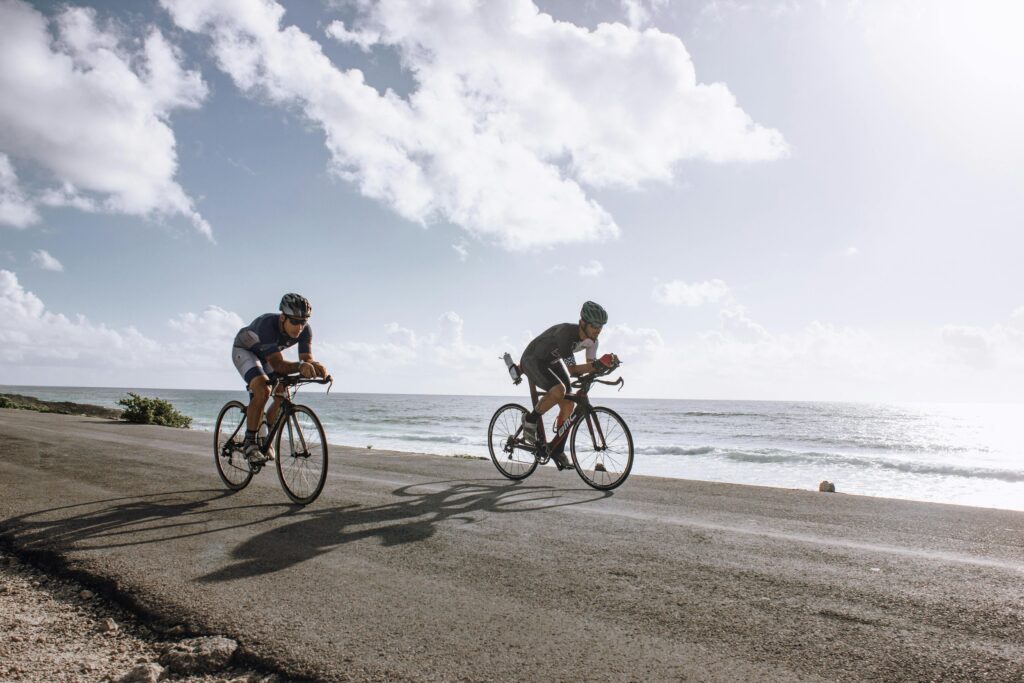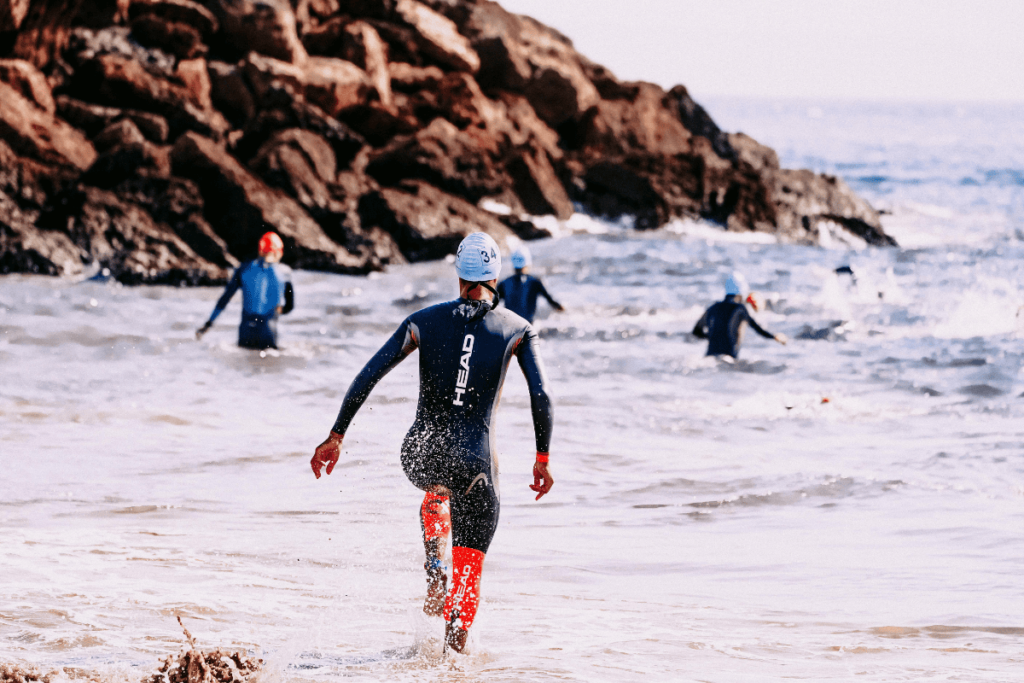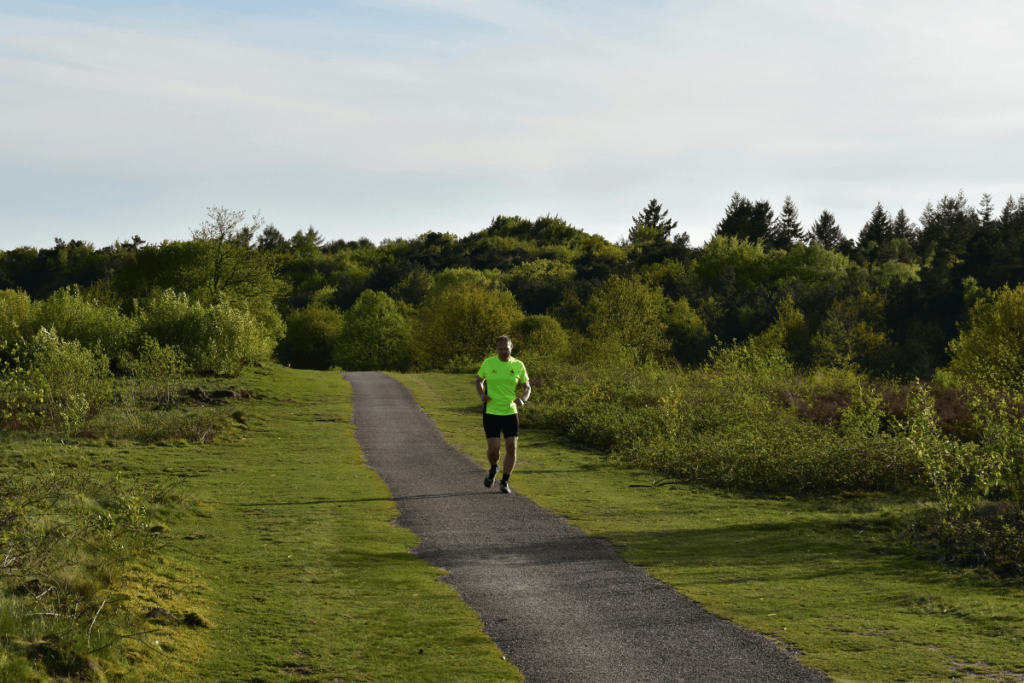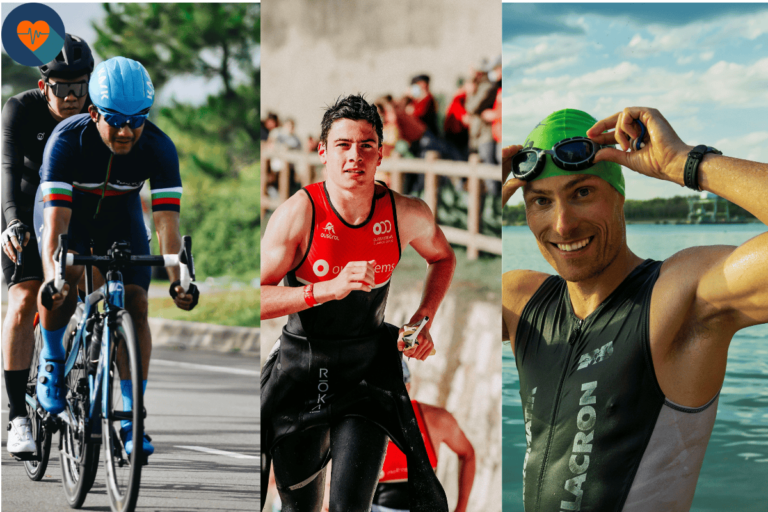Starting a triathlon might seem scary at first, but it’s definitely doable. As a beginner, swimming, cycling, and running back-to-back might feel tough. But trust me, it’s a journey that changes you in amazing ways.
It boosts your physical shape and builds mental toughness. Completing it will bring you a great sense of pride.
Whether you’re just starting off in the world of fitness or are looking for a new challenge, this guide’s for you. From the basics down to how to master the three main disciplines, you’ll learn to be a confident triathlete.
Table of Contents

The guide also has an 8-week plan for beginners, which starts slow and gets progressively harder as it prepares the trainee for a sprint triathlon. You build endurance, improve speed, and practice transitioning between swimming, biking, and running.
Are you ready for an amazing adventure? Let’s start exploring triathlon training together. Get ready for a great challenge, find that inner strength, and celebrate your first triathlon finish.
Knowingthe Basics of Triathlon
The triathlon is a great sport that involves swimming, cycling, and running. This sport will test your endurance, your strength, and how well you adapt to different areas. Knowing the basics whether you’re a seasoned or new triathlete will make the journey rewarding.
What is a Triathlon?
A triathlon is a competition that involves swimming, cycling, and running. The transition from these sports should be smooth. It showcases their prowess in multi-sports.
Common Triathlon Distances
Triathlons come in different lengths, fitting various skill levels and goals. Here are some common ones:
- Sprint distance: 750m swim, 20km bike, 5km run
- Olympic distance: 1.5km swim, 40km bike, 10km run
- Half Ironman (70.3): 1.9 km swim, 90 km bike ride, and 21.1 km run.
- Ironman (140.6): 3.8km swim, 180km bike, 42.2km run
Benefits of Triathlon Training
There are numerous advantages of triathlon training, including:
- Improved heart health
- Stronger muscles
- Increased strength and power
- Better mental toughness
- The opportunity to make and achieve personal goals
Triathlon training can prepare an athlete in all aspects: physically, mentally, and attitudinally. It can push any individual into new realms of achievement in both body and mind.
Essential Equipment and Gear
Getting ready for a triathlon involves acquiring all the right equipment. From swimming to biking and running, each part needs its special provisions. Let’s explore the main triathlon gear you will need to start.
For the swim portion, you’ll need a swimsuit or triathlon suit, goggles, and a swim cap.. Many athletes also use a wetsuit for better buoyancy and warmth in the water.
You will be mounting a road or triathlon bike and wearing a helmet that has met safety criteria. And, of course, having a bike repair kit with you for having tools to fix flats or make adjustments.
For the running part, you will need properly fitted running shoes according to your foot and running style. You may want to wear a hat or visor to protect you from the sun.
Transition areas also require special equipment. Accessories such as a race number belt, elastic laces, and a water-resistant sachet help in keeping things tidy. These will make transitions seamless.
As a starter, you do not have to invest much in equipment. Find comfortable and useful accessories that suit your budget. With proper equipment, you are set for a great day of the race.
In triathlon gear, quality will mean much when it comes to your training and racing. Knowing the requirements for each part of the race helps you prepare well for your next triathlon.
Getting Started with Swimming

Swimming is the foundation of triathlon training. Whether you are a seasoned veteran or a beginner, much of your time will be consumed by swim training and perfecting your freestyle technique. This will prepare you well for open water swimming and the triathlon swim.
Pool Training Techniques
The first thing you can do is work on your technique and endurance in the pool through interval training and drills. If you learn how to position your body, stroke, and breathe effectively, then those things will be easier to do when you’re swimming in open water.
- Practice swimming with minimal kicking to preserve energy by swimming laps.
- Try catch-up freestyle and other variations to create a more efficient stroke.Do sets of short sprints and then longer swims to get faster and stronger.
Open Water Swimming Skills
As you get better, focus on open-water swimming skills. Knowing how to swim in different conditions, sight, and handle group starts are very important for a good triathlon swim.
- Practice sighting to stay on course and swim straight.
- Get accustomed to open-water swimming, including how your wetsuit feels and the sensation of waves and currents.
- Join open water swimming events or group sessions for real experience.
Swimming Form and Efficiency
Good form during a swim helps save energy for a good performance in the triathlon swim. The body should be long, rotate to the sides, and kick less.
Be able to swim 100 yards without stopping before commencing your triathlon training. This will not only set you up for success in the pool but also in open water.
Mastering the Cycling Component
Cycling forms the most significant part of triathlon training. Cycling successfully on the bike part will be determined by working on your endurance, refining your cycling techniques, and having an appropriate bike fit.
In triathlon cycling, endurance is a very prominent factor. Long rides develop your endurance. Try maintaining a pedaling velocity of 80 to 90 revolutions per minute. This enables you to travel faster without easily getting tired.
Secondly, correct cycling technique is important. Develop the skills of pulling your pedals up and pushing down. Your pedaling then is more in a circle, which also is much stronger, as your legs are balanced during each revolution. This will make you feel better during long rides.
Getting your bike fit is very important. Work with a bike fitter to adjust the seat, handlebars, and more. A well-fitted bike can make a huge difference in performance.
Incorporate indoor cycling on a smart trainer into your training. You are able to work on your heart rate, intervals, and pedaling form in a controlled environment. Combine indoor and outdoor rides for a well-rounded cycling program.
Focus on endurance, technique, bike fit, and indoor cycling to improve your skills in cycling for triathlon training.
Developing Your Running Strategy

The running part of being a triathlete demands mastery to guarantee your success. A good running strategy involves two important components: building endurance and perfecting form. Master these and you will run better and become victorious in triathlons.
Running Form and Technique
Good running form prevents injuries and saves energy. Keep your head up, shoulders back, and eyes forward. Try for a short, quick stride, and use your core for stability.
Building Running Endurance
To become good at triathlons, build running endurance gradually.Include long runs, interval training, and hill workouts in your routine. Gradually add more miles and time each week to allow your body to adapt.
Brick Workouts
Brick workouts, switching from bike to run, mimic triathlon demands. They help you get used to the physical and mental changes. Start with short sessions and grow them to prepare fully.
Consistency is key in triathlon training. By focusing on these areas, you’ll build strength, endurance, and confidence for triathlon running.
| Triathlon Distance | Swim | Bike | Run |
|---|---|---|---|
| Sprint | 0.5 mile | 12 miles | 3 miles |
| Olympic | 0.9 mile | 24 miles | 6 miles |
| Ironman 70.3 | 1.2 miles | 56 miles | 13.1 miles |
Triathlon Training Schedule
The creation of a good triathlon training plan is the key for beginners. It should last 8 to 12 weeks. This time helps your body get ready for the race.
Begin with 2-3 swim sessions, 2-3 bike rides, and 2-3 runs each week. This mix helps you improve in each sport. Use a periodized plan for the gradual increase in the intensity of the training plan.
Also, don’t forget to factor in rest days and recovery weeks. These will prevent injuries and burnout. Train in training zones for intensity regulation and the body’s adaptation.
| Week | Swim | Bike | Run |
|---|---|---|---|
| 1 | 3 x 30 min | 2 x 45 min | 3 x 30 min |
| 2 | 3 x 45 min | 2 x 1 hr | 3 x 40 min |
| 3 | 3 x 1 hr | 2 x 1 hr 15 min | 3 x 45 min |
| 4 | 3 x 1 hr 15 min | 2 x 1 hr 30 min | 3 x 50 min |
By having an organized structure of working out and a planned training schedule, you can conquer your first triathlon. Be consistent on your journey, but patient as well.
Nutrition and Hydration Guidelines
Proper triathlon nutrition and hydration are important for optimal performance. With the use of proven strategies, you’re able to fuel your body right, and this warrants an excellent triathlon experience.
Pre-Training Nutrition
Before training, food intake can include complex carbohydrates and low-fat meals, which can give you energy without causing an upset stomach. Aim for a balanced meal with whole grains, lean proteins, and veggies.
Race Day Fueling
On race day, sports hydration and race-day fueling are important. Consume easy-to-digest carbohydrates to maintain energy. For shorter races, use 30-60 grams of carbohydrates per hour. For longer races use 60-90 grams per hour.
Drinking enough water is also important. Aim for 500-750 ml per hour if a runner, and 750-1000 ml per hour if a cyclist. And remember to add electrolytes such as sodium to replace lost salts.
Recovery Nutrition
After racing or training, focus on recovery meals comprising carbs and protein. This replenishes your energy stores and also helps in muscle repair. Therefore, attempt to get 20-30 grams of protein within 30-60 minutes following the workout.
By following these triathlon nutrition and hydration tips, you will be well-fueled. This, in turn, will help enhance your recovery and performance on your triathlon journey.
Race Day Preparation
Now that the big day is finally near, it is time to tweak your race strategy, get mentally prepared, and make sure your equipment is ready. Arriving early to set up your transition area and warm up properly can make a big difference on race day.
Start by reviewing the course in detail, familiarizing yourself with the terrain, turns, and any potential challenges. Pacing will be crucial, so practice visualizing your race and how you’ll approach each discipline. Stay calm and focused, remembering the hard work you’ve put into your training.
- Check all your equipment thoroughly, from your bike to your running shoes, to avoid any last-minute issues.
- Gradually warm up by incorporating light jogging and dynamic stretches to get your body ready for the race.
- Utilize visualization techniques to boost confidence and manage pre-race nerves.
- For the swim, bike, and run components, start off conservative, maintain a consistent pace throughout the event, and avoid early burnout
| Transition Area Timing | Nutrition Tips |
|---|---|
| In big races, the transition area might close several hours before the wave start time, for example, closing at 7 a.m. while the wave starts at 10 a.m. | Timing nutrition is crucial; aim to finish a full meal approximately three hours before the race starts. Consider having a gel 15-20 minutes before starting if there is a long gap between breakfast and the race to ensure proper fueling. |
Through good preparation and maintaining focus on your race strategy, you are well set for a good, enjoyable triathlon experience.
Transition Area Skills
In a triathlon, transitions should be made with minimal time loss. A smooth transition from one discipline to the other can save not only time but energy also. We shall examine here the principal techniques for T1 and T2 respective transitions from swim to bike and then from bike to run.
T1: Swim to Bike
Transition swim-to-bike is all about speed and coordination. The best athletes would often only put on their helmets and take their bikes. Taking your wetsuit off and quickly donning your cycling gear will help shave off seconds.
Arrive early to scope the transition area out and lay out your gear. Rehearse the T1 sequence until it becomes automatic. This helps build confidence, too, which can save precious seconds.
T2: Bike to Run
The transition from the bike to the run is all about quick thinking and physical preparedness. Pay attention to everything without getting too distracted. In most cases, heart rates are highest during this phase.
In T2, pay more attention to the important tasks first. Avoid putting on your helmet until last to avoid any penalties. Moving dismounts are great for transitioning faster onto the run. Ensure your running shoes and gear are easy to grab.
Practice T2 in training, incorporating video analysis to identify further improvements you can make. You’d be surprised how minor adjustments-such as picking up your gear while in motion-can shave valuable seconds off your transition time.
Triathlon training requires mastery of the transition skills. Triathletes improve with both practice at T1 and T2 and can have an advantage on race day.
Injury Prevention and Recovery
As a triathlete, keeping the injuries at bay is very important. Overtraining, not enough rest, and poor technique can all cause injuries. The following tips are to be added to your training if you are to remain healthy and perform well.
- Cross-training – Try strength training, yoga, and swimming. The three build strength and flexibility without overworking the muscles.
- Active recovery – Use your rest days for light jogging, cycling, or swimming. This keeps you moving without straining yourself too much.
- Stretching and mobility include stretching time, foam rolling, and mobility exercises. They keep joints loose and prevent stiffness.
Listen to your body and avoid overtraining. Follow a structured training program that allows recovery days. If you have persistent pain, consult with a physical therapist or sports medicine professional.
For injury prevention, balance is key. Mix cross-training, active recovery, and stretching. This way, you stay healthy, avoid injuries, and keep improving in triathlons.
Conclusion
Your triathlon journey is a fantastic undertaking that requires dedication, patience, and regular training. Setting realistic goals for yourself during this sporting challenge will help you commemorate your progress with due credit. Completion of the first triathlon is an achievement, so feel proud about it.
Build on that experience and look for areas to improve, then set some new challenges for the next one. Stay motivated through communication with fellow triathletes by joining local groups and clubs. This not only keeps you accountable but also offers a supportive forum with which to share your triathlon journey.
Keep in mind that the road to being a successful triathlete is one of the constant setting of goals and continuous improvement. The right mindset and strategies will carry you to new heights in athletic performance and personal growth. Enjoy the journey, trust the process, and enjoy that thrill at the finish line.
FAQ
What is a triathlon?
A triathlon is a multisport event. It involves swimming, cycling, and running.
What are the standard triathlon distances?
Triathlon distances differ. Sprint races boast a 750m swim, 20km bike, and 5km run. Olympic races boast a 1.5km swim, 40km bike, and 10km run.
What are the advantages of triathlon training?
Triathlon training strengthens your heart, muscle endurance, and your mind.
What is the must-have gear to have when participating in a triathlon?
You will be required to have a swimsuit, goggles, and a bicycle; equally important, running shoes and a helmet. Other possible equipment includes a swim cap, cycling shorts, and a heart rate monitor.
How should I go about swimming training for a triathlon?
Turn your attention to swimming techniques, endurance, and open-water skills. Aquatic drills in the pool can help with the fine-tuning of form. Open water skills would include learning sighting and navigating in various conditions.
What would be the key focus for cycling training?
Cycling training should enhance your endurance, cadence, and form. You should use smooth pedaling and make sure that your bike fits well. Indoor cycling with a smart trainer helps offer workouts effectively.
How do I develop my running strategy?
Run with your head up and shoulders back for better breathing. Increase your endurance by slowly building up your resilience through constant training. Brick workouts help simulate race conditions and practice transitions.
What does a typical triathlon training schedule look like?
Beginners train for 8-12 weeks. In that time, they do 2-3 swim sessions, 2-3 bike rides, and 2-3 runs per week. The plan will also include base, build, and peak phases, with rest days and recovery weeks.
How important is nutrition and hydration in triathlon training and racing?
Nutrition and hydration are fundamental to training and racing. Ingest complex carbohydrates before training, simple carbohydrates during and after training, and keep fluid levels up. A post-workout meal should include a mix of carbohydrates and protein.
How do I prepare for race day?
Study the course and review your equipment before race day. On race day, arrive well ahead, set Transition up, and warm up. Relax and stay focused, but remember all of your training and goals.
How can I improve my transition area skills?
Quick transitions save time in a triathlon. Practice T1 and T2 transitions during training. Set up a mock transition area and focus on fast gear changes.
How can I avoid injuries while training for a triathlon?
Minimize injury risk by gradually increasing your training load, getting adequate rest, and incorporating cross-training. Prioritize stretching and mobility exercises, and pay attention to your body’s signals, addressing any pain or discomfort immediately.
Looking for more fitness tips and workouts? Visit our Fitness category for a wealth of articles to support your fitness journey!

